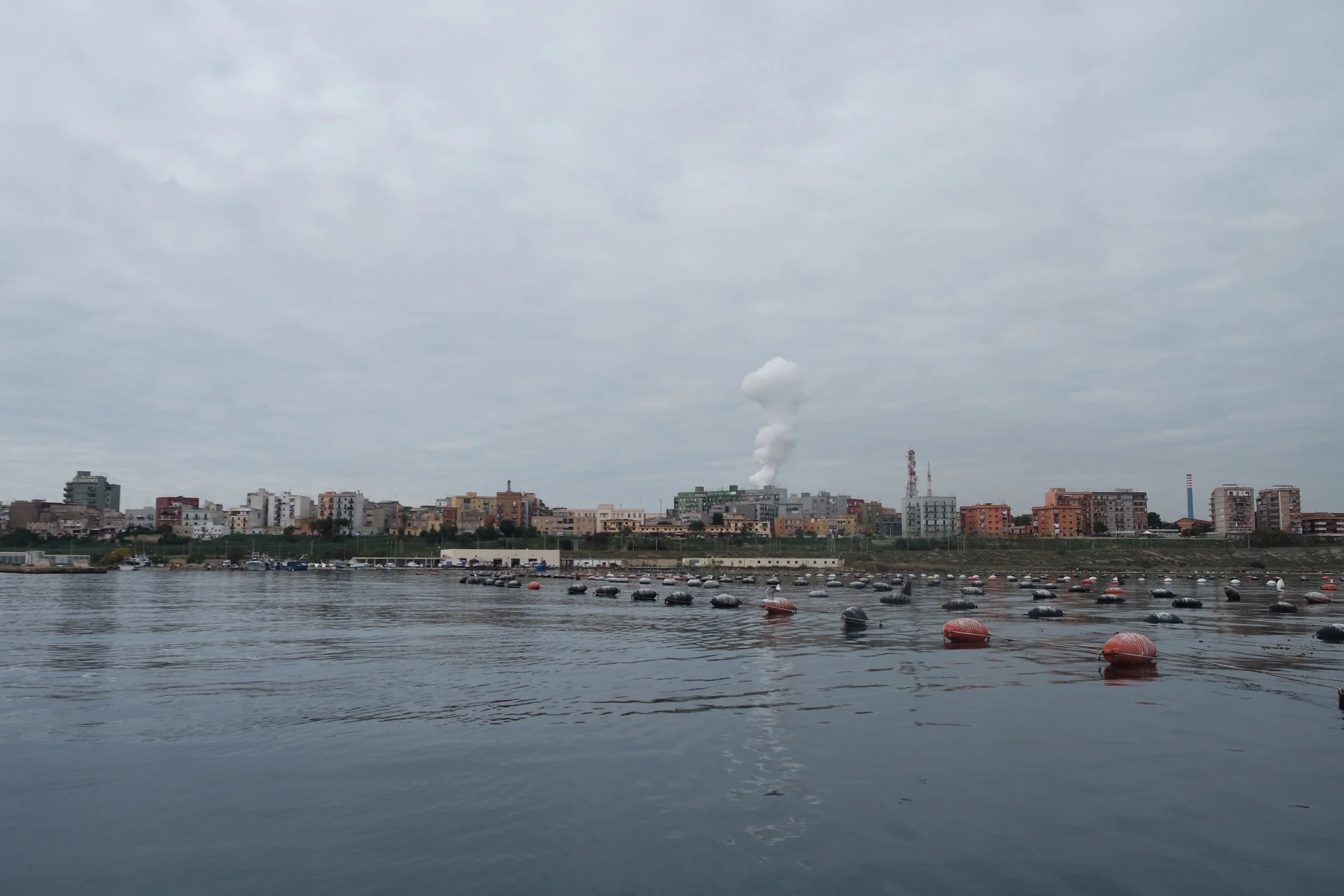Taranto, Laboratory of a New Sea Policy or Never-Ending Disaster?
by Dora Farina, Novella Gianfranceschi, Federica Scannavacca
Although Taranto is often associated with the fumes of Ilva, responsibility for the city’s environmental degradation does not lie solely with the steel plant. Industrial activities have often been hidden behind the city’s architectural structure, which for years concealed the uncontrolled disposal of waste and exploited the sea exclusively for human benefit, without recognizing it as a natural resource to be respected.
A forward-looking sea policy could have prevented such abuses, protecting the Mar Piccolo and its delicate ecosystem.
The brackish basin, of great ecological value, has for decades been heavily contaminated by the discharge of pollutants, particularly from the Navy Arsenal. Along the coast to the south, the sea disappears from view for about three kilometers, hidden by what locals call the “Taranto Berlin Wall”: a seven-meter-high fence enclosing roughly 90 hectares of the military Arsenal. According to data from CNR, ISPRA, and ARPA Puglia, the waters in front of the Navy area show high concentrations of polychlorinated biphenyls (PCBs), asbestos, arsenic, mercury, and lead — well above safety limits.
Ecological and Cultural History of the Mar Piccolo
From above, Taranto looks like an hourglass: in the upper chamber lie the districts of Statte, Tamburi, and Paolo VI, home to the former Ilva and Eni plants; in the lower chamber stretch the new city, Spartan ruins, and the Navy Arsenal. Connecting the two is the old town, an island linked to the mainland by two bridges that also connect the Mar Piccolo with the Ionian Sea. This configuration enables the presence of freshwater springs in the Mar Piccolo, called citri, which ensure low salinity and natural thermal regulation.
These features make the lagoon an extraordinary habitat for species such as seahorses, nudibranchs, and especially the Taranto black mussel, recognized as a Slow Food Presidia since 2022. For its environmental potential, the Italian Environmental Fund (FAI) has included the lagoon among its “Luoghi del Cuore” (“Places of the Heart”) and supports its candidacy as a protected area, so that it may finally be safeguarded through a new sea policy. In fact, due to its historical criticalities, the Mar Piccolo is one of forty-three Sites of National Interest (SIN) — areas that are heavily contaminated and, due to the extent or severity of pollution, require remediation and safety interventions under direct state authority.
The Failure of Remediation and Public Management
Like an hourglass, Taranto measures the time lost in unfulfilled promises of environmental recovery, starting with the cleanup of the Mar Piccolo.
In 2012, a memorandum of understanding between the State and the Apulia Region was supposed to launch operations, but — over a decade after its signing — the results are minimal. Four different commissioners have been appointed since 2012, and their management has been marked by delays, overlaps, and a lack of transparency. The current commissioner, Vito Felice Uricchio, had to wait a year to fully take office due to delays in the government’s appointment of the commissioner’s structure.
His work has also been slowed by debt left by the previous commissioner, Vera Corbelli, who held the role between 2014 and 2020. As stated in the minutes of the parliamentary inquiry commission on environmental crimes, Corbelli declared she had managed €214 million, mostly from the EU Cohesion Fund, the financial instrument designed to reduce economic disparities among Italian regions.
The resources spent exceeded the available funds, creating a deficit. Despite formal requests for access to documents sent to both the Ministry of the Environment and the current commissioner, Vito Felice Uricchio, it has not been possible to determine the precise amount of the debt. The Court of Auditors has also confirmed the absence of accounting investigations into the remediation process.
All of these points to a governance vacuum preventing the implementation of a solid and credible sea policy.
The Condition of Mussel Farming
Pollution in the Mar Piccolo has serious repercussions, above all on mussel farmers, custodians of one of the area’s gastronomic treasures: the Taranto black mussel. For about two seasons now, mussels have been unable to complete their life cycle. Today, fish markets mostly sell “Irish mussels,” as indicated by labels from the Taranto Fish Center.
Mussel farming in Taranto is threatened mainly by two factors: pollution and climate change. Being filter feeders, mussels absorb the contaminants present in the water, while rising temperatures can kill them. In recent years, the Mediterranean Sea has recorded record-high surface temperatures, often above 30 degrees Celsius, with peaks up to 5 degrees above historical averages, endangering the survival of many marine species.
To counter pollution, in 2016, the Apulia Region issued an ordinance imposing strict controls on dioxins and PCBs, requiring mussel farmers to move mussels by February 28 from the first inlet of the Mar Piccolo—the most favorable area for growth but also the most contaminated—to the second inlet, which is less suitable for cultivation. As mussel farmer Vincenzo Guarino of the Uila union explained to Voice Over Foundation:
“Since it is shallower and warmer, moving mussels to the second inlet reduces oxygen levels in the water, leading to their death”.
An effective sea policy should prevent such paradoxes, balancing environmental health with economic survival.
Between Virtuous Examples and Contradictions
The difficulties faced by mussel farmers highlight how false the opposition is between economic interests and environmental protection. As marine biologist Roberto Danovaro of the Polytechnic University of Marche explains: “The quality of marine ecosystems is fundamental for fishing, bathing, tourism, and the territory as a whole. There is no conflict between environment and production”.
Danovaro also stresses the importance of collective responsibility: “Much of the damage to marine ecosystems comes from past industrial activities, often the result of ignorance rather than malice. Decades ago, awareness of the environmental value of the sea and the impact of our actions was lacking.
Today, environmental protection is no longer a choice but a constitutional principle enshrined in Articles 9 and 41 of the Italian Constitution.”
Despite the fact that “Italy is among the most advanced European countries in marine ecosystem restoration,” Danovaro continues, “the management and cleanup of the Mar Piccolo does not seem to be among the institutional priorities”. This is confirmed by its absence from the MER project (Marine Ecosystem Restoration), a €400 million plan representing the largest national effort ever launched for the study, protection, and regeneration of Italian marine and coastal ecosystems. The project’s main activities include the reconstruction of natural oyster beds (Ostrea edulis) in five Adriatic regions, the completion of mapping of sensitive habitats such as Posidonia oceanica, and the exploration of marine depths up to 4,000 meters using underwater robots.
Yet the Mar Piccolo of Taranto is not included, and — as can be verified on OpenPNRR, an independent civic monitoring platform analyzing and making transparent the data on Italy’s National Recovery Plan implementation—no projects are listed for the Mar Piccolo. This signals a fragmented sea policy still lacking a systemic vision.
Taranto, Laboratory of a New Sea Policy
Thus, more than a decade after cleanup efforts began, the citizens of Taranto are still waiting for genuine remediation and clarity about institutional delays. On January 15, 2025, several local associations, including Legambiente and Libera, held a flash mob in front of the Mar Piccolo, symbolically pronouncing a verdict of condemnation.
“In the name of the polluted people of Taranto, we condemn inaction, complicity, and silence,”
declared an activist dressed as a judge during the demonstration.
With the campaign “Ecojustice Now,” the community is demanding the release of already-allocated funds, an acceleration of the remediation process, and concrete commitments for a sustainable future for Taranto, a city now “tired of dying from pollution.”
“As of today, Taranto lacks a shared vision of what the Mar Piccolo could become for its community”, says Alessandro Esposito, independent researcher and member of the Convocatoria Ecologista collective.
“As Convocatoria Ecologista, we are trying to build an alternative vision for Taranto that does not compartmentalize problems but reads them within the broader space of living—whether in the city, the province, or the countryside. The same applies to the Mar Piccolo: there is no coherent, long-term vision for the entire territory, and this absence has obstructed any real attempt at remediation”.
For this reason, the collective organizes workshops of collective counter-narration, such as Toxic Bios, through which they seek to politicize individual experiences in the city, transforming the “toxicity” of pollution and loss of space into a sense of community desire. “We have imagined the shoreline beyond the Arsenal wall, to restore the connection with the sea.” For Esposito, the alternative is not another industry — such as tourism — but rather
“a city to be traversed, not sold but inhabited”,
where caring for the territory means fostering forms of agroecological cooperation and supporting mussel farming as a collective tradition, at the heart of a renewed sea policy. For Taranto, and beyond.




